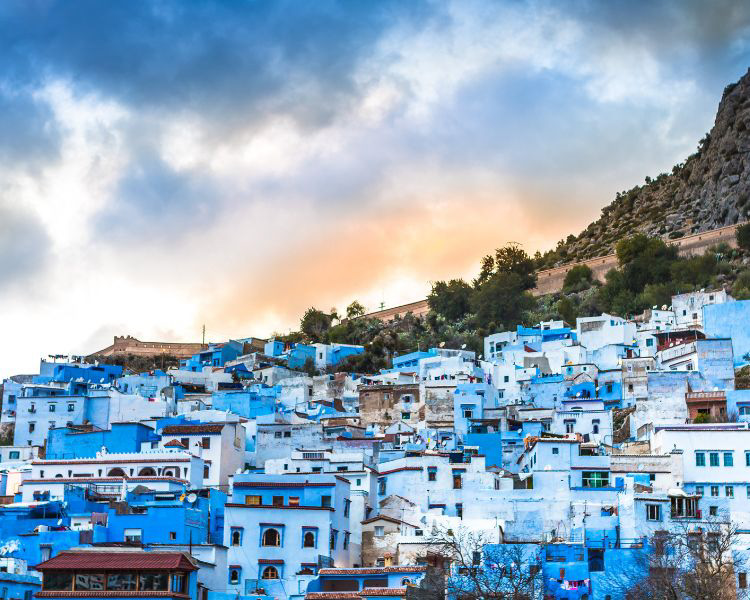Introduction
Morocco is a beautiful country with a rich history and a myriad of interesting attractions which should be included in your itinerary when you visit this North African nation. Here are some of the top attractions that you need to see in Morocco.
The Blue City of Chefchaouen
In a North African nation with as much color as Morocco, the blue city of Chefchaouen still manages to stand out. Turquoise, indigo, and teal buildings line its narrow streets, while vibrant crafts and clothes are sold at the northeastern city’s medina. The beautiful backdrop of the Rif can be enjoyed from the Plaza Uta el-Hammam. Just south lies the waterfall at Ras al-Maa, which takes less than an hour to reach. Muslims and Jews peacefully coexisted in Morocco until the mid-20th century, and evidence lies in cities like Chefchaouen. Jewish sellers bringing saffron often stopped on their way from Fez to Tangier, and some stayed in Chefchaouen.
Other Jewish communities shared this peaceful, diverse sentiment, which can still be enjoyed in Moroccan culture today. The museum in the Mellah features pottery, photographs, and costume arts, rare religious artifacts, and 15th-century chronicles written in Hebrew. Whatever your preference, every Moroccan rose has its numerous thorns. It doesn’t matter the kind of romantic you are, there should be something to see and do on this list that will make you fall in love with this diverse North African country. It’s no exaggeration to call Chefchaouen the most charming town in all of Morocco, generation-old blue-washed buildings hug close to each other on steep and winding streets, and the combination of brilliant and sky blue houses feels like the Mediterranean in its most beautiful form. Even travelers passing through will want to schedule a few extra days.
The Ancient Medina of Fez
Declared a UNESCO World Heritage Site in 1981, Fez is Morocco’s third largest city and headquarters of the Kingdom’s Muslim spiritual leaders. Fez has preserved its prestige, as it is an authentic medieval city filled with the sites and sounds of a bygone era. It boasts an impressively well-preserved medieval old town with many hidden gems such as artisan quarters, old merchant markets, theological colleges, and the world’s oldest university. Today, Fez boasts six thousand alleys and a primeval state that attracts thousands of international historians, architects, and tourists to its maze-like alleyways to explore this authentic ancient city.
The Majestic Sahara Desert
One of my goals during my year-long excursion to Morocco was to get to experience the grandiose majesty that is the Sahara desert. So, a couple of friends and I took a three-day camel trek through the desert. We were off to an adventurous start when a whirlwind stranded us at the rendezvous point as we waited for our desert caravan guide, Omar, and the twelve Bactrian camels. This natural event was followed up by a spectacular occurrence of Pokéranda thunder and lightning, which showered us with ample amounts of rain. Mother Nature provided a truly remarkable start to our desert adventure! It was an unforgettable, mystical, and magical experience that we had in the Sahara.
I would never be able to find words or take photographs that would ever do the actual experience justice. As with anything stemming from Africa, the Sahara has to be seen to be believed and I would say head for Morocco, for the shortest flights and the best deals, if you’ve never seen this great desert and have it on your personal “places to see” list. Who else ever gets the opportunity to shamble through the desert by camel, sleep beneath the stars, and kiss the dunes a good morning as dawn rises? It’s a wonderful world in more ways than one, as I continue to explore the awe and wonder of my new home abroad.
The Vibrant City of Marrakech
There is no place on Earth like Marrakech! Stepping back in time, you find yourself in a kaleidoscope of colours, sounds, and smells that are simply intoxicating. The line between life and theatre here seems to dissolve, flakes of gold float in the air, and the sounds of musical bands, acrobats, and comic street performers are always just around the corner. Centuries of history resound from the great square and its surrounding narrow streets. It transports you spiritually to the Middle Ages, where hundreds of people a day gather around the heart of Marrakech – Djemaa el-Fna – to enjoy the entertainment along with the street food vendors tempting their customers with local delicacies. Between the performances, the square also houses an array of shopping stalls – from herbs used as natural remedies to spices, nuts, and fruit, to jewelry, clothing, and artifacts.
The Historical Kasbah of Ait Ben Haddou
The historical Kasbah of Ait Ben Haddou is a distinctly constructed group of pise buildings surrounded by high walls. The group is a traditional pre-Saharan habitat. The Ksar of Ait-Ben-Haddou, on the old caravan route, was once abundant. Merchants were here taking care of business during the time. Then, for one reason or another, the Ksar was abandoned to the elements. Today, though, the Ksar is protected by the UNESCO World Heritage Convention. The buildings, especially the lookouts between the terraced houses, are something to be admired. On the segments of the road from the Ksar to the river, one can see numerous palm groves and abandoned buildings. The floodplain is around the river. Many communities who had survived over time still live in the new district of Aït Ben Haddou.
This district has also gotten bigger as the floodplain has been built upon. The Ksar of Aït Ben Haddou is a wonderful example of “Moroccan earthen clay architecture.” During some periods, many Ksars and above all many Kasbahs were built inside, such as the fortified Ksar of Aït Ben Haddou. Essentially, the homes in this Ksar are grouped together in blocks surrounded by fortifications. The word “Ksar” refers to the physical structure while the word “Kasbah” refers to the community surrounding the Ksar.
The Coastal Town of Essaouira
Morocco is a country with a mixture of color, culture, and life. It is a magical place for the senses. Picturesque views and enchanting sounds await travelers around every corner. The attractions, culture, and traditions that draw visitors to Morocco are its striking location, natural architecture, and the people providing an accessible doorway to one of the most fascinating cultures on earth. This African country has a great deal to offer its tourists, and every town seems to have its own character and story. Each visit to Morocco can be a contrast where travelers might spend their mornings wandering through the colorful maze of the local souk and their afternoons relaxing in a luxury hotel beside the Atlantic Ocean.
The Imperial City of Meknes
The name Meknes is often associated with its name in the world of Roman antiquity, which is Meknassa (a member of the Berber Wei tribe founded it). Meknes, founded in 711 by Umayyad leader Qutaibah ibn Muslim, spread further during the reign of Idris ibn Abdallah and became the capital of the country. The Almohads built city walls around Meknes and opened large gates in 1144. Under the leadership of the subsequent Marinides, Meknes shone in known fields of science, religion, crafts, and trade. Today Meknes is a city of art with dozens of festivals, contests, and art meetings as well as a destination for those interested in finding delicious Moroccan cuisine. Over the years, the city has retained its historical and classic texture, as described by the novelist Volubiliana historic, the French writer Gaius Lucius in the 1930s. The silent, mysterious peace of the city is depicted beautifully in the words of Elise Benaray-Howe, an American author who lived in Meknes: “I hear the call to prayer. Half a minute later, I heard the same sounds echoing through Meknes from a different direction.
The Roman Ruins of Volubilis
Located near the city of Meknes in Morocco, the ancient Roman ruins known as Volubilis are of great archaeological interest. Considering it is within a manageable distance of Fes and Meknes, there’s no reason not to stray from the typical tourist path to check them out. While the outlines of several structures have been clearly defined by archaeologists and are in very good condition for the most part, to the delight of history enthusiasts everywhere, the best-preserved ruins are those of the houses of the wealthier inhabitants of the city. It was not until the mid-18th century when the ruins of Volubilis were discovered by the then-ruling Sultan of Morocco.
The sultan allowed the tomb robbers to bring to light the floor of mosaics, but nothing had been preserved from this wealth – all have been taken outside the country. Since 1915, a local administration has been formed to protect the co-existence and guardianship of the surrounding areas. The attraction was declared a national heritage official.
In the outskirts of the city, between the gardens, fieldstone walls hide the highways and flooring. The remains of the 16th-century mosque, a known source of attractions in Volubilis, are located right in the heart of the city, at the intersection of the major areas such as the Basilica and Cabdus’ House. Other attractions of this historical site consist of Travertine, the public toilets under the loculi, and homes of rich and important inhabitants. It dates back to around 206 AD the time of the reign of the famous Marc Aurele. It is a market building devoted to oil commerce and to the district capital. The district capital was a part of the National domain.
The Diverse Atlas Mountains
This vast range of mountains, valleys, plateaus, and deserts stretches from the Sahara in the south to the Atlantic Ocean in the west and the Mediterranean in the north. Not only are the mountains full of surprising decorative touches and designs, but they are also a varied collection of people from urban and rural areas. The mountains also provide a home to many species, including the Barbary Macaque, the only species of Macaque monkey outside Asia. Divided into sections by the Draa, Ourika, and God Rivers, the High Atlas, Anti-Atlas, Middle Atlas, and the Saharan Atlas represent the different sections of the mountain ranges. Due to its close proximity to Marrakesh, the High Atlas, the tallest peak of the range, is the most visited section and draws ramblers from all over the world, as well as attracting snow sport and adventure tourists.
Conclusion
Morocco is a melting pot of culture, with ancient and modern men sitting seam by seam. The country is growing increasingly popular as a holiday destination for its never-ending sunshine, awe-inspiring beaches, and historic cities that are drenched in layers of culture. The attractions are never in short supply in Morocco, and it can prove to be difficult to know where to start your journey. Fear not, we’ve gone ahead and found 10 sight-seeing attractions that everyone must see and do during their Moroccan vacation.
Overall, Morocco has a variety of enterprise attractions that will leave their visitors more than just impressed. It’s a country that invites people from all walks of life to experience a variety of activities from horse-trekking through the Atlas Mountains to relaxing boutique riads in the central labyrinths of Marrakesh. This country has something for every kind of traveler to make them fall in love with its raw beauty and, naturally, colorful charm. Let yourself experience all that Morocco has to offer by booking a 10 days desert tour from Casablanca to this exceptional country.
Stay in touch to get more updates & news on Gossips!




